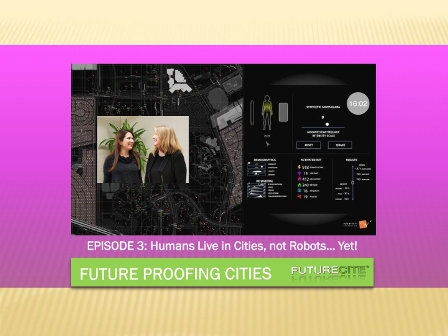
So what do cities need to do to prepare for the future? Well, every city is different and complex – given that cities need to consider key issues such as economics, infrastructure, mobility, security and evacuation planning.

In Episode 3 Myrna shares insights on why cities need to consider in modeling how they plan and allocate resources to new projects. This includes the adoption of sensors, which will soon be mainstream in applications for mobility, transport, utilities and the impact on how to design communities. Without fully understanding how people will react to new layers of digital adoption on their everyday Living & Lifestyles, all levels of government need to understand how the responses of their citizens, communities and companies play out in each scenario considered. Without doing so, decisions may be costly – both economically and socially, as each city has its own complexities and cultural ways of doing things. Its more difficult to undo infrastructure changes that impact citizens, communities and companies – after the fact. Unlike robots were programming can usually be reversed, human societies in the different cities each have their own different complexities. After all, humans still live in cities and not robots….yet!
Traditionally the focus of municipalities has been on infrastructure allocation, policy, demographics and economics. As history will attribute, politics in general may influence decision-making and the economic outcomes of cost sharing infrastructure projects amongst the various levels of governments. We are now in a new future where technology will play a key role in building cities, and key decisions without due research and knowledge of scenario outcomes may alter the course of a city’s global competitiveness – attracting investment, industry and human talent
In planning for future uncertainty, integrating new technologies (as in 3D Synthetics) need to brought alongside existing strategies, plans and data to identify the gaps, challenges and opportunities, and enable administration and politicians to understand the outcomes of specific scenarios. From these scenarios, municipalities can better see the citizen responses (for examples, using live simulation of synthetic people) planning future scenarios.
Stay tuned for Episode 4 on modeling the future of Healthcare!
Myrna Bittner

Myrna is the founder and CEO of RunWithIt Synthetics (RWI). Myrna passionately lives and promotes the imperative for inclusion, diversity, and representation. Armed with her BA in English, and while finishing her MBA, Myrna started her first tech company in 1992, and developed a commercial internet groupware product used by NASA and US West for real-time remote communications. She co-founded her next company, a 3D neural net visualization research company – funded by an Australian billionaire. When they told her she couldn’t do it, it did not stop her. She continued on her AI journey to create what is now RWI.
About RunWithIt Synthetics (RWI)

RWI de-risks the future with Synthetic Intelligence Environments, and enables innovators to plan and act, with certain and quantifiable answers to the most sophisticated questions about exponential future scenarios. RWI stepped out of the limitations of digital twinning and historical data, demonstrating for our partners their systems at scale, in the future, under any circumstance they could imagine. RWI produced emergent experiences that could be designed, measured, understood and optimized — enabling their partners to confidently move years ahead of competition in both innovation and delivery. RWI’s Synthetic Intelligence Environments have validated tech capacity for major M&A deals, de-risked the rollout of global massive scale live media systems, and exposed threat surfaces in IoT tech— running 24/7 to deliver billions of hours of accurate and instructive data. In 2019, RWI’s Synthetic City implementation tackled IIoT, infrastructure mitigation, and disaster response during earthquakes in Silicon Valley.




